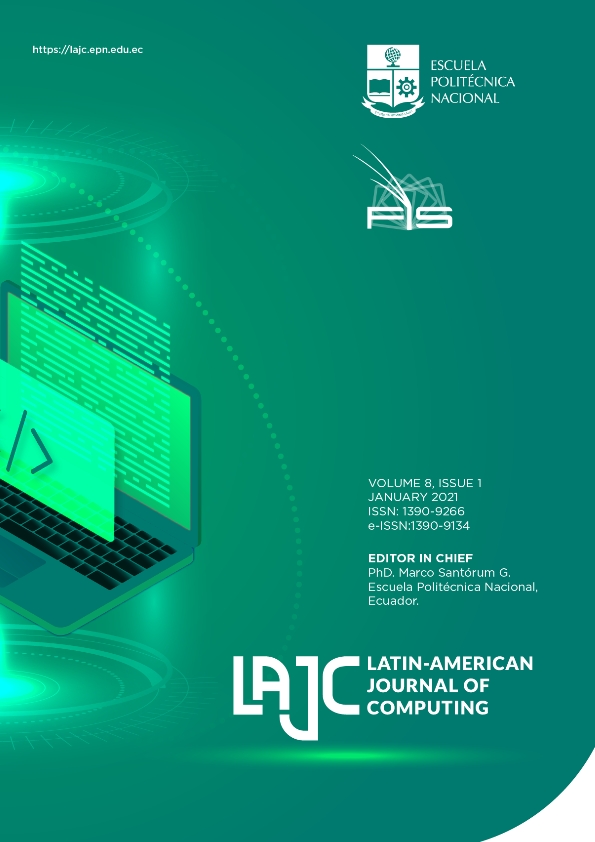Switching Systems Synthesis Method Using Permuted Gray Code Tables (PGC Method)
Keywords:
Boolean functions, discrete problems, Gray Code, Hamiltonian Paths, hypercube, switching systemsAbstract
Finding the shortest function on switching systems is a necessity for the development of efficient automatic systems. Currently, several methodologies aim to solve this need with different techniques. This article proposes a new methodology to find a propositional formula that describes a switching system problem using several truth tables which are based on an original one; these tables are generated using Gray Code principles and permutations. As it will be shown, the used code has a direct relation to the Hamiltonian paths, where each permutation is a different connection in a hypervolume, and each node is represented as a bit combination. An algorithm was developed using MATLAB and compared with the solutions from the software Boole-Deusto to verify and validate the applicability and implementation of the method. Finally, examples of execution, computational cost comparison and future work proposals are presented.
Downloads
References
J. P. Roth, "Algebraic topological methods for the synthesis of switching systems. I.," Transactions of the American Mathematical Society 88.2, pp. 301-326, 1958.
W.V. Quine "A way to simplify truth functions." The American mathematical monthly 62.9, pp. 627-631, 1955.
M. Karnaugh, "The map method for synthesis of combinational logic circuits," Transactions of the American Institute of Electrical Engineers, Part I: Communication and Electronics 72.5, pp. 593-599, 1963.
R.B Hurley, "Probability maps," IEEE Transactions on Reliability 12.3 pp. 39-44, 1963.
Astola, Jaakko, and R. Stankovic. “Fundamentals of Switching Theory and Logic Design A Hands-on Approach,” Springer, 2006.
E.W. Veitch, "A chart method for simplifying truth functions," Proceedings of the ACM national meeting (Pittsburgh), 1952.
Bitner, R James., Gideon Ehrlich, and E.M. Reingold. "Efficient generation of the binary reflected Gray code and its applications," Communications of the ACM 19.9, pp. 517-521, 1976.
W. Press, et al. Numerical recipes in Fortran 77: volume 1, volume 1 of Fortran numerical recipes: the art of scientific computing. Cambridge university press. 1992.
J. Zubia, J. García, Sanz Martínez, and S. Borja, "BOOLE-DEUSTO, la aplicación para sistemas digitales," 2001.
J. Dybizbanski, and A. Szepietowski, "Hamiltonian paths in hypercubes with local traps," Information Sciences 375, pp. 258-270, 2007.
K. Sankar, V. Jaya, M. Pandharipande, and P. S. Moharir. "Generalized gray codes," Proceedings of 2004 International Symposium on Intelligent Signal Processing and Communication Systems, ISPACS IEEE. 2004.
D. Benavides, “Diseño, implementación y evaluación de unidades didácticas de matemáticas en MAD 2,” pp. 265. 2019.
L. Egghe and I. Ravichandra Rao, "Classification of growth models based on growth rates and its applications," Scientometrics 25.1, pp. 5-46, 1992.
Downloads
Published
Issue
Section
License
Copyright Notice
Authors who publish this journal agree to the following terms:
- Authors retain copyright and grant the journal right of first publication with the work simultaneously licensed under a Creative Commons Attribution-Non-Commercial-Share-Alike 4.0 International 4.0 that allows others to share the work with an acknowledgement of the work's authorship and initial publication in this journal.
- Authors are able to enter into separate, additional contractual arrangements for the non-exclusive distribution of the journal's published version of the work (e.g., post it to an institutional repository or publish it in a book), with an acknowledgement of its initial publication in this journal.
- Authors are permitted and encouraged to post their work online (e.g., in institutional repositories or on their website) prior to and during the submission process, as it can lead to productive exchanges, as well as earlier and greater citation of published work.
Disclaimer
LAJC in no event shall be liable for any direct, indirect, incidental, punitive, or consequential copyright infringement claims related to articles that have been submitted for evaluation, or published in any issue of this journal. Find out more in our Disclaimer Notice.










